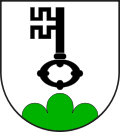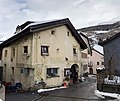Sent GR
| GR is the abbreviation for the canton of Graubünden in Switzerland and is used to avoid confusion with other entries of the name Sent . |
| Sent | ||
|---|---|---|
| State : |
|
|
| Canton : |
|
|
| Region : | Engiadina Bassa / Val Müstair | |
| Political community : | Scuol | |
| Postal code : | 7554 | |
| former BFS no. : | 3763 | |
| Coordinates : | 820 863 / 189132 | |
| Height : | 1440 m above sea level M. | |
| Area : | 111.61 km² | |
| Residents: | 899 (December 31, 2013) | |
| Population density : | 8 inhabitants per km² | |
| Website: | www.sent-online.ch | |
|
Sent GR |
||
| map | ||
|
|
||
Sent ( ; German Sins ) is a village in the municipality of Scuol in the Sur Tasna district in the Inn district of the Swiss canton of Graubünden .
Until December 31, 2014 Sent was an independent political municipality . On January 1, 2015 Sent was merged with the four municipalities of Ardez , Ftan , Guarda and Tarasp into the municipality of Scuol.
geography
Sent is a place in the Lower Engadine , which is located on a sun terrace above the Inn at approx. 1450 m above sea level. The former municipality has 877 inhabitants (end of 2009). The factions Sur En , Crusch , Sinestra and Zuort belong to Sent .
history
Sent is first mentioned in the year 930. Almost 500 years later, in 1400, the former municipal area had the same extent as it is today. In addition to the neighboring municipality of Scuol , Sent was the largest municipality in the Engadine between 1572 - 300 houses, 1000 inhabitants - and 1900 . Sent was formerly also called Sinz and Sindes . Onomastically , the name and its origin have not been interpreted to this day.
In 1499 an Austrian army incinerated Sent. With major fires in 1596, 1748, 1823, 1911 and 1921, this was by no means the only catastrophic fire.
Awards
On November 19, 2011, the community received the “ Energy City” label for its ecological efforts .
coat of arms
Blazon : In silver over a green three-hill, a black key placed on a pole, the attribute of the church patron Peter
The hill with the ruins of St. Peter's Church is the community's landmark.
population
languages
The Graubünden Romanesque dialect Vallader has remained the language of the majority of the population to this day. It was used by all residents until well into the 19th century. But until 1970 there was a small German-speaking minority. In 1880 88%, in 1910 already 89%, in 1941 even 91% and in 1970 still 86% of the population stated Romansh as their colloquial language. Since then, the proportion of German speakers has increased significantly. This is also shown in the following table:
| Languages in Sent | ||||||
|---|---|---|---|---|---|---|
| languages | 1980 census | 1990 census | 2000 census | |||
| number | proportion of | number | proportion of | number | proportion of | |
| German | 89 | 12.79% | 154 | 20.00% | 232 | 26.82% |
| Romansh | 561 | 80.60% | 567 | 73.64% | 591 | 68.32% |
| Italian | 32 | 4.60% | 23 | 2.99% | 15th | 1.73% |
| Residents | 696 | 100% | 770 | 100% | 865 | 100% |
Romansh is supported by the community and the school. In 1990 86% and in 2000 84% of the population understood Romansh.
Religions and denominations
The former community did not join the Reformation until 1576 , much later than the other Lower Engadine towns.
nationality
Of the 877 residents at the end of 2009, 795 were Swiss nationals.
Culture and sights
regional customs
The festival of Babania is celebrated on January 6th .
Buildings
- The steeple of the reformed church can be seen from afar , which was only built in its current pointed shape at the end of the 19th century. The church itself is much older.
- At the entrance to the village are the ruins of the old church Baseglia San Peder , which was probably built around the year 1200. After the Reformation, the church slowly fell into disrepair. The tower was used at times as an ammunition and powder magazine. That is probably why it is still standing. The building is owned by the family of the poet Peider Lansel .
- Houses decorated with sgraffito are typical of Sent .
- Chasa dals Spus
- Chasa Schigliana, 2000, Architects: Rolf Furrer , Christof Rösch
- House Augustin
- Kurhaus, in Val Sinestra
- Palazzo Corradini
- Villa Schucany
- Schmid house
- Defila residential building
- Stupaun House
- Covered wooden bridge
Senter gable
Senter gables can be found as an architectural peculiarity mainly in Sent, and less often in other villages in the area. The special feature is the curved shape of the roof gable . It came to the Engadine at the end of the 18th century through South Tyrolean craftsmen. Over time, this baroque gable shape became a feature of the village and therefore received its name.
Arable terraces
Agriculture used to be practiced on the hillside of Sent . In order to cultivate the slope, it was converted into terraces. The steep sections between today's cattle pastures consist of hedges, a landscape that is unique in Switzerland. Many species of birds find a habitat there.
Nickname
In the tradition of nicknames of the Engadine villages , the Senter ils are called asens (English: the donkeys ).
Personalities
Due to their origin or stays and activities associated with Sent are among others:
Writers and publicists
- Gaudenz Barblan (1860–1916), teacher at the first secondary school in the Lower Engadine in Sent, poet of the Engadine hymn Chara lingua da la mamma
- Nicola Bardola (* 1959), author, journalist, translator.
- Cla Biert (1920–1981), writer. Lived in Sent from 1978.
- Valentin Crastan (* 1932), engineer, author
- Manfred Koch (* 1955), literary scholar, essayist and literary critic. Lives in Sent since 2007.
- Peider Lansel (1863–1943), poet and promoter of Romansh. Married to a senator and temporarily resident here.
- Armon Planta (1917–1986), teacher, poet and promoter of Romansh and hobby archaeologist, especially Roman paths.
- Angelika Overath (* 1957), literary scholar, journalist, writer. Lives in Sent since 2007, her work Alle Farben des Schnees was published in 2010 . Senter diary.
- Andri Peer (1921–1985), writer, born in Sent.
- Jon Pult (1911–1991), publicist and language politician
- Conradin Riola (1667 / 1670–1743), reformed clergyman and theological writer
- Angiolina Vonmoos (1862–1955), poet from Sur En
Visual artist
- Gottfried Honegger (1917–2016), painter and sculptor.
- Max Huggler (1903–1994), art historian. Lived temporarily in Sent.
- Wolfgang Laib (* 1950), object and installation artist. Showed an exhibition in the “Chasa dal guvernatur” in 2009 - since then his “cell” lined with beeswax has stood there.
- Gian Enzo Sperone , art dealer and gallery owner in Rome, New York ( Sperone Westwater ) and Sent. Since 2006 owner of the "Chasa dal guvernatur" and operator of the gallery there.
- Not Vital (* 1948), sculptor, painter, draftsman, engraver. Creator of the Parkin “Not dal Mot”. Works in the “Chasa dal guvernatur”.
Musician
- Willem Mengelberg (1871–1951), conductor and composer. Lived temporarily on Hof Zuort , donated the chapel there.
- Warren Thew (1927–1984), pianist, composer, poet and draftsman. From 1972 lived temporarily in Sent; Since then has written Rhaeto-Romanic poems and songs.
tourism
The main source of income for the place is tourism . In winter, many guests come to the neighboring village of Scuol to take the mountain railway to the Motta Naluns ski area .
economy
In summer, Senter farmers jointly cultivate two Alps . The milk is mainly processed into cheese, which is sold in the local cheese dairy .
literature
- Hans Bernoulli : The reconstruction of Sent. In: Heimatschutz = Patrimoine , Vol. 17, 1922, pp. 2-10 ( digitized version ).
- Erwin Poeschel : The art monuments of the canton of Graubünden III. The valley communities Räzünser Boden, Domleschg, Heinzenberg, Oberhalbstein, Upper and Lower Engadine. (= Art Monuments of Switzerland. Volume 11). Edited by the Society for Swiss Art History GSK. Bern 1940. DNB 760079625 .
Web links
- Virtual tour taken by Heiko Stachel
- Official website of the municipality of Sent
- Paul Eugen Grimm: Sent. In: Historical Lexicon of Switzerland .
Individual evidence
- ↑ Jules Coulin : To rebuild the burned down part of the village in Sent . In: Heimatschutz = Patrimoine , Vol. 16, 1921, pp. 102-106 (digitized version).
- ↑ Fadrina Hofmann: “This label obliges us to act sustainably”, in: Die Südostschweiz from November 14, 2011, p. 4
- ↑ http://www.sent-online.ch/cumuen/baselgias/sanpeder.html
- ↑ Chasa dals Spus
- ↑ Chasa Schigliana
- ↑ Augustin House
- ^ Kurhaus
- ^ Palazzo Corradini
- ^ Villa Schucany
- ↑ Schmid's house
- ↑ Defila house
- ↑ Stupaun House
- ↑ Covered wooden bridge
- ↑ http://www.sent-online.ch/cumuen/chasas/culmainas/index.html , Sent
- ↑ http://www.sent-online.ch/cuntradas/terrassas/index.html
- ^ Nicola Bardola in the portrait of the community of Sent
- ^ Cla Biert in the portrait of the community of Sent
- ↑ Chasper Pult: We are happy. That you came back with “Culur”. Speech on the occasion of the inauguration on August 9, 1997, accessed on November 4, 2010.
- ^ Max Huggler in a portrait of the community of Sent .
- ^ Contemporary art from Not Vital to Vik Muniz Article in engadinerpost.ch from August 18, 2012
- ^ Gian Enzo Sperone: Wolfgang Laib. With a foreword by Marco Meneguzzo: Cells / Celle. Exhibition catalog. Sperone, Sent 2009. (English / Italian)
- ^ Gian Enzo Sperone in the portrait of the municipality of Sent
- ↑ Not Vital at Sikart .
- ^ Willem Mengelberg in the portrait of the community of Sent
- ^ Warren Thew in the portrait of the parish of Sent
- ↑ WP article on Warren Thew is in preparation.











